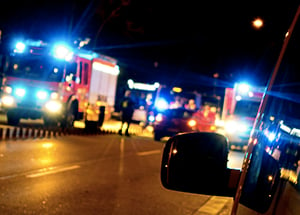Paramedics in Ada County, Idaho, unveiled their new ambulance last month, and it’s anything but ordinary. The vehicle, plated in black bulletproof metal and funded by a grant from the Department of Homeland Security, will accompany the Ada County Paramedics’ Tactical Medical Team when it joins SWAT teams in the field.
Traditionally, paramedics here turned armored SWAT trucks into makeshift ambulances when responding to calls. Now, the new armored ambulance allows them to treat and transport patients safely on gurneys. It provides more room, better light, as well as the ability to carry additional medical equipment and safely store oxygen. Most of all, it gives first responders more protection in “hot zones” so they can provide victims with immediate, life-saving care.
Across the country, paramedic teams and local law enforcement are weighing the pros and cons of armored ambulances. Ada County made the move to secure its armored vehicle after a 2016 shootout in Boise injured two police officers, paralyzing one from the waist down. Other cities, such as San Leandro and Milpitas, California, have purchased similar armored vehicles to boost their ballistic protection.
First Responders Face Increasing Danger
The changing role of first responders makes a strong case for added protection. Emergency medical teams (EMTs), paramedics and firefighters face increasing dangers as they provide more immediate medical care, particularly in active shooter situations.
Normally, paramedics and fire departments waited in secure zones away from the scene until it was safe to enter and rescue victims. But the alarming number of mass shootings in the past two decades has taught law enforcement valuable lessons about making every second count. Active shooter incidents often last a few short minutes, so tending to victims within seconds can mean the difference between life and death.
Now, first responders across the country are trained to accompany police officers into hot zones to offer rapid, life-saving care. Many now wear bulletproof vests and helmets to increase protection amid growing personal risk.
The use of armored ambulances offers paramedics another layer of protection and gives them the ability to administer on-site medical attention they would otherwise be unable to offer. But bulletproof ambulances are not without their critics.
Do Armored Ambulances ‘Militarize’ First Responders?
While the vehicles purchased in Ada County, San Leandro and Milpitas offer ballistic protection, they also resemble military tanks and feature gun ports. This sets many community members on edge who feel that armored vehicles – whether weaponized or not – create a warlike atmosphere and only serve to escalate heightened situations.
In an attempt to calm fears, the San Leandro police department held a special city council meeting to educate community members prior to the purchase. While law enforcement officials reinforced the importance of getting first responders into hot zones quickly, many community members voiced their opposition.
“Seeing that vehicle outside, it didn’t make me feel safe,” remarked one resident. “It made me feel like, ‘Why do I feel like I’m being put in a war zone.’”
Others made comparisons to the protests in Ferguson, Missouri, where many felt the use of armored law enforcement vehicles only served to escalate an already volatile situation.
Some cities have gone in a different direction. The Los Angeles Unified School District’s police returned three grenade launchers to the Department of Defense. The cities of San Jose and Davis, California, each returned Mine Resistant Ambush Protected Vehicles (MRAPs).
Ambulance manufacturers are starting to take these sensitivities into account. The REV Group, based in Milwaukee, recently introduced the Guardian, its first model made with ballistic protection. Wrapped in Level 3A ballistic-resistant material, the Guardian looks much more like a traditional ambulance than a tank and offers run-flat tires and ballistic-resistant glass windows.
“While it is unfortunate that this sort of ballistic protection is needed,” said Bob Collins, president of REV Ambulance Group, “the market has requested the development of an ambulance that does not look like an armored military vehicle and functions like a normal ambulance while providing increased safety to crews if they are involved in potential active shooter situations.”


